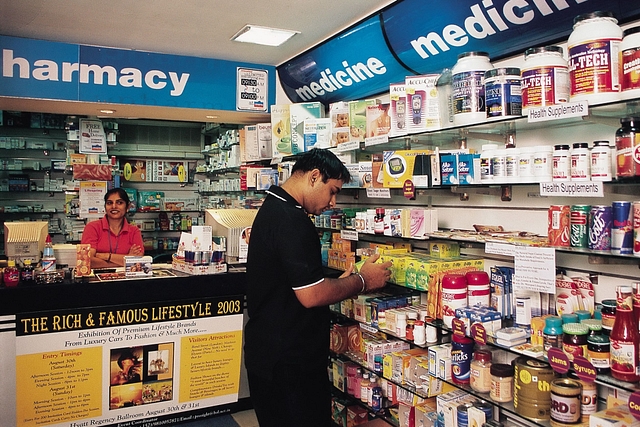
Cheaper Medical Drugs And Devices For All: The Steps Taken By The Government In The Past Five Years
It will be important to include consumables along with drugs in the DPCO to control undue profiteering.
The national pharmaceutical policy should be finalised to enable access to affordable medicines and promote generic drugs.
According to the 71st Round of the National Sample Survey Office, 63.5 per cent of the total out-of-pocket spending on healthcare in India, is dedicated to outpatient care. Of this, the largest share of expenditure (71 per cent) is on medicines. This is a paradoxical situation because while on the one hand, India is amongst the largest suppliers of generic medicines in the world, on the other, a large part of the country’s population lacks regular access to quality essential medicines.
In 1995, the National Pharmaceutical Pricing Authority (NPPA) had for the first time enforced the Drug Price Control Order (DPCO) to enhance the availability of essential drugs at affordable prices. DPCO 2013 expanded the scope of the National List of Essential Medicines and enforced a price ceiling on several formulations across different therapeutic classes. The formulations specified in the first schedule of DPCO 2013 include medicines used in the treatment of cancer, tuberculosis, diabetes and cardiac ailments. The DPCO excludes new drugs patented under the Indian Patent Act for a period of five years from the date of their marketing in order to promote research and development.
Over the last few years, the government has taken several steps to lower the prices of essential medicines. Last month, the NPPA put 42 anti-cancer medicines under a 30 per cent trade margin cap. With effect from 8 March 2019, this move slashed the maximum retail price of 390 medicine brands by about 87 per cent. Such an approach has been attempted for the first time and can pave the way for a new paradigm of self-regulation by the industry.
It is expected that over 22 lakh cancer patients will benefit from this measure and the annual savings to consumers could amount to Rs 800 crore. This move assumes even greater significance in the light of the fact that for cancer patients the out-of-pocket spending on health care related costs, of which medicines constitute a large chunk, is approximately 2.5 times more than for other conditions.
Prior to the imposition of the trade margin cap on anti-cancer medicines, the government had brought about 958 drugs under price control. This represents a 140 per cent increase over the 404 drugs that were under price control in 2014.
In addition to medicines, price control has also helped to make several widely used medical devices more affordable. For instance, the prices of Drug Releasing Stents, which are used for treating blocked arteries, have been lowered from Rs 1.98 lakh in 2014 to Rs 28,849 now. Similarly, the prices of Bare Metal Stents have been reduced from Rs 75,000 in 2014 to Rs 7,923 currently. These are significant measures because India has over 6 crore cardiac patients of whom approximately 5 lakh undergo the stent procedure every year. Price control has also been imposed on knee implants which now cost Rs 54,720 compared to Rs 1.58 Lakh in 2014.
While price control is an important step, the government has also utilised other mechanisms for enabling access to essential drugs and medical devices at affordable prices. Over 5,000 Jan Aushadhi stores have been established across the country during the last few years. The Medical Devices Rules were also notified by the Ministry of Health in 2017. Previously, only 15 categories of devices had been subject to regulation, that too under the umbrella of drugs. Further, to improve the availability of quality diagnostics across health facilities in India, the “National Essential Diagnostics List" has been drafted.
Citizens can also access free medicines and diagnostics at the 150,000 health and wellness centres proposed to be set up across the country under the Ayushman Bharat programme. Over 14,000 such centres are currently operational in different states. Similarly, under the Pradhan Mantri Jan Arogya Yojana (PM-JAY), drugs and medical devices will be available to patients free of cost at empanelled secondary and tertiary care facilities. As of 12 March 2019, 14,865 hospitals had been empanelled under PM-JAY and over 15 Lakh beneficiaries had received treatment.
Going forward, it will be important to include consumables, along with drugs, in the DPCO to control undue profiteering as suggested in NITI Aayog’s ‘Strategy for New India @ 75’. The national pharmaceutical policy should also be finalised to enable access to affordable medicines and promote generic drugs. Further, in addition to setting up more Jan Aushadhi stores, any challenges with their business model should be ironed out so that they can function as self-sustaining entities.
With respect to medical devices, a suitable pricing policy should be formulated in order to enable access to affordable devices for the population while also ensuring a sufficient return on investment. The draft ‘National Essential Diagnostics List’ should be finalised for enhancing the affordability of diagnostic tests, improving their regulation and quality as well as promoting their rational use.
Disclaimer: Views expressed are personal.